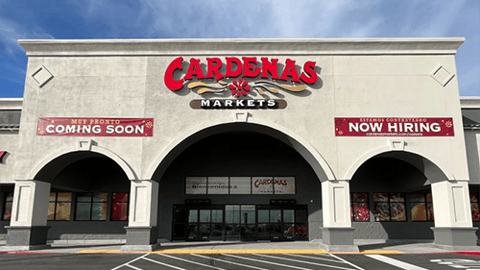How Grocers Can Embrace Latino Cultural Influence
For decades, Latinos in the United States were identified as a multicultural group with a common thread: language. Today, the Latino population stands as a unique cultural blend, profoundly influencing the expansive melting pot that characterizes our nation. A journey through the grocery aisles provides a lens to view the shift from a mixture to a distinctive identity.
Bodegas and Colmados
As an essential part of the Latino communities, the bodegueros (grocers) and colmados (grocery stores) intuitively understood the desires and needs of their customers. They became the conduits, sourcing the ingredients that Latinos needed for their sazón (flavor). There was no longer a need to smuggle ingredients in suitcases or luggage. Latinos could venture to leave their barrios (neighborhoods), but never their colmados.
[Read more: "EXCLUSIVE: Heritage Grocers CEO Discusses Importance of Multicultural Grocers"]
The Turning Point
As Latino numbers and economic power grew stronger, supermarkets took notice, and the “international aisle” was born. Latinos didn’t have to go to colmados for Latino ingredients and the supermarket for everything else anymore. They felt included as members of their larger community, underscoring the importance of accessibility.
The love affair between Latinos and supermarkets quickly deepened, sparking a race to offer the most authentic experience possible. Supermarkets wanted to make Latinos feel at home and started offering everything from plátanos and chiles to “homemade” guacamole and tortillas, as well as pan dulce, churrasco and chorizo. Suddenly, Latino tastes and flavors were in the main aisles, available to everyone.
A Unique Opportunity for Supermarkets
As more than half of Americans identify as foodies, the kitchen has become a hub of innovation. Exploring and appreciating new foods and flavors may foster cross-cultural dialog and understanding. Multicultural ingredients and dishes can be a source of creative satisfaction and a deeper understanding of our fellow Americans and the world.
In particular, Latinos are influencing and shaping a culture and cuisine that are unique to the United States. What began as a focus on authenticity has evolved into a rethinking of classics and the design of totally new dishes. Today, tacos have eclipsed pizza as the country’s most popular dish, while Latino beer and spirit brands are commanding serious market share and even dominance. Latino culture is growing into a strong force in the United States, influencing and innovating within the new mainstream.
In this landscape, supermarkets have a unique opportunity to be more than transactional spaces.
All Flavors Welcomed
Supermarkets could see themselves as community centers where culinary creativity is ignited and cultural exchange flourishes, safe places of inclusion and acceptance, where all flavors are indeed welcomed and celebrated. To that end, they should establish partnerships with local organizations to enhance community engagement and strengthen customer connections. In the same way that the kitchen is the heart of the home, one could say that supermarkets are at the center of their communities.
[Read more: "What’s the Flavor of the Year for 2024?"]
Embrace Culinary Creativity
Supermarkets have the potential to become hubs for culinary creativity. They can provide dedicated spaces for multicultural cooking demonstrations, recipe displays and ingredient pairings, and inspire customers to experiment with both local and international ingredients, fostering a sense of adventure and discovery.
Facilitate Cultural Exchange
Operators should position supermarkets as catalysts for cultural exchange, create platforms for customers to share their culinary experiences and traditions, and consider organizing themed events or collaborations with local communities to celebrate diversity, fostering a sense of unity among shoppers.
Engage, Inspire and Educate
They should also showcase the richness of global cuisines and celebrate cultural diversity. One way to do that is by organizing cooking classes, cultural events and food festivals, which can serve as platforms for customers to learn about multicultural traditions, creating a deeper appreciation for diverse culinary traditions and ingredients. They can collaborate with chefs, food bloggers and community leaders to host events, share recipes and engage with customers, leveraging these influencers to promote the supermarket as a cultural hub.
[Read more: "How Culturally Relevant Food Marketing Promotes Health"]
Transform Shopping Into an Inspiring Journey
Grocers should position every shopping trip as a journey of inspiration and connection. They can do this by embracing and adopting multicultural seasonal holidays, learning and promoting the dishes made and shared during these events. These efforts will showcase how the supermarket isn’t just a place to buy groceries, but also a destination for culinary exploration and cultural celebration.
Grocers can also involve customers in the ongoing evolution of American culture through their shopping experiences, encouraging shoppers to share their culinary stories and traditions, and creating interactive spaces within the supermarket where customers can contribute to the cultural narrative, leading to a sense of shared identity.
Looking Ahead
One thing remains crystal clear: The embrace of Latino and other multicultural flavors in mainstream America isn’t merely a passing trend, but a transformative force that will shape the way we eat, cook and connect. Through the lens of food, the Latino community will continue to make a lasting impression on the American palate, celebrating diversity, fostering cultural understanding, and ensuring that the journey from smuggled spices to a mainstream force remains an enduring story of flavor, resilience and unity.






